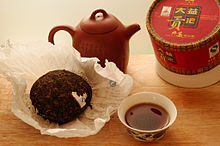
Back شاي بوير Arabic Puer Azerbaijani Пуэр Byelorussian Пуэр BE-X-OLD Pu erh Breton Pchu-er (čaj) Czech Пуэр CV Pu-Erh German Pu-erh Spanish Pu’er (tee) Finnish
| Pu'er | |
|---|---|
 | |
| Type | Fermented tea |
| Other names | 普洱茶 |
| Origin | Yunnan, China |
| Pu'er tea | |||||||||||||||||||||||
|---|---|---|---|---|---|---|---|---|---|---|---|---|---|---|---|---|---|---|---|---|---|---|---|
| Chinese | 普洱茶 | ||||||||||||||||||||||
| |||||||||||||||||||||||

Pu'er or pu-erh[1] is a variety of fermented tea traditionally produced in Yunnan Province, China. In the context of traditional Chinese tea production terminology, fermentation refers to microbial fermentation (called 'wet piling'), and is typically applied after the tea leaves have been sufficiently dried and rolled.[2] As the tea undergoes controlled microbial fermentation, it also continues to oxidize, which is also controlled, until the desired flavors are reached. This process produces tea known as hēichá (黑茶), literally "black tea", though the term is commonly translated to English as "dark tea" to distinguish it from the English-language black tea (紅茶 hóngchá, lit. "red tea" in Chinese).
Most teas, although described as fermented, are actually oxidised by enzymes present in the tea plant. Pu'er is fermented microbially by molds, bacteria and yeasts present on the harvested leaves of the tea plant, truly fermented.
There are two main styles of pu'er production: a traditional, longer production process known as shēng (raw) pu'er; and a modern, accelerated production process known as shóu (ripe) pu'er. Pu'er traditionally begins with a raw product called "rough" (máo) chá (毛茶, lit. fuzzy/furry tea) and can be sold in this form or pressed into a number of shapes and sold as "shēng chá (生茶, lit. raw tea). Both of these forms then undergo the complex process of gradual fermentation and maturation with time. The wòduī (渥堆) fermentation process developed in 1973 by the Kunming Tea Factory[3][4] created a new type of pu'er tea. This process involves an accelerated fermentation into shóu (or shú) chá (熟茶, lit. ripe tea) that is then stored loose or pressed into various shapes. The fermentation process was adopted at the Menghai Tea Factory shortly after and technically developed there.[5] The legitimacy of shóu chá is disputed by some traditionalists when compared to the traditionally longer-aged teas, such as shēng chá.
Pu’er can be stored and permitted to age and to mature, like wine, in non-airtight containers before consumption. This is why it has long been standard practice to label all types of pu’er with the year and region of production.
- ^ Yoder, Austin (2013-05-13). "Pu'er Vs. Pu-erh: What's the Deal with the Different Spellings?". Tearroir. Archived from the original on 2016-05-07.
- ^ Chen ZM (1991), p. 438, chpt. "Manufacturing pu'er [普洱茶的制造]"
- ^ Zhang (2013), p. 206, appx. 1: "Puer Tea Categories and Production Process"
- ^ TeaHub.com (2013). "Talks about Black (Shu/Ripe) Pu-erh". Articles3K.com. Archived from the original on 2016-05-30. Retrieved 2014-05-03.
- ^ Zhang (2013), p. 45, chpt. 1